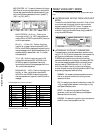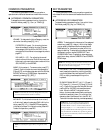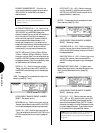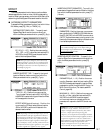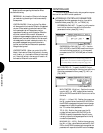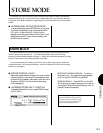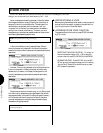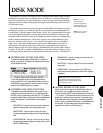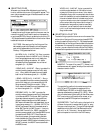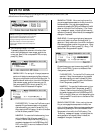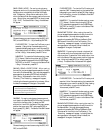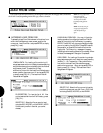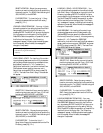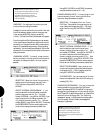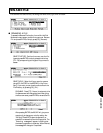
DISK MODE
132
VOICE (.A1V) - A W5/W7 Voice type data file
contains a complete bank of 128 Internal normal
voices plus 2 Internal drum voices. Voice data is
offloaded to floppy disk in a complete Internal voice
bank with elements, but can be loaded back into the
Internal voice bank either all voices at once (includ-
ing drum voices) or one voice into a specific Internal
voice number (excluding Internal drum voices). If
the destination song memory location has a Song
voice bank, you can load the Internal voice bank
into it, or you can load a single Internal voice into a
Song voice number.
● SELECTING A FILE TYPE
To select a file type, position the cursor over the name of the
subfunction of the type of file you want and press ENTER,
or simply press the function key [F2 ~ F6] located beneath
the abbreviation of the file type name located at the bottom
of the screen. If the operation is a saving or renaming type
function, you can name the file and view the File Directory,
and execute the operations from within either subfunction.
NAME FILE - To name a file, press [F7] ( Name ) and
the Name screen will appear, where you can enter an 8-
character name for the file.
To name the file, position the inverted arrow pointer
with [F4] and [F5], and select characters with the
CURSOR keys, INC/DEC, or the JOG. A blank letter
space can be entered by pressing [F3] ( [SPC] ). When
you ve finished entering the name, you can either press
EXIT once to return to the subfunction screen, or go
ahead and press ENTER to perform the operation.
FILE DIRECTORY -˚The File Directory displays the list
of files on the currently inserted disk by type (i.e., song
file type, voice file type, etc.). The type of files displayed
depends on which particular Disk Mode subfunction
you re in (i.e., All, Voice, etc.). You can perform the
particular operation from within the File Directory.
● SELECTING FILES
Whenever you choose a Disk Mode saving and loading
function, a subfunction menu of file types will appear. This
menu lets you access the type of file data to save to or load
from a floppy disk.
To select the various file types, position the cursor over the
name of the type of file you want to perform the operation
on and press ENTER or simply press the function key [F2
~ F6] located beneath the abbreviation of the function name
located at the bottom of the screen.
FILE TYPES - After saving a file, the file type will be
delineated by a period followed by a three-character
code, which appears after the file name in the File
Directory. File types are as follows:
ALL DATA (.A1A) - A W5/W7 All Data type data
file contains all data in the W5/W7 multi, including
the 16 songs (sequencer and/or multi data) plus
accompanying Song voice banks. All data is
offloaded from and loaded back into an internal
song bank (01 ~ 16) RAM.
1 SONG (.A1Q) - A W5/W7 1 Song type data file
contains one song (sequencer and/or multi data)
only. 1 Song data is offloaded from and loaded
back into an internal song bank (01 ~ 16) RAM.
1 SONG + VOICE (.A1S) - A W5/W7 1 Song +
Voice type data file contains one song (sequencer
and/or multi data) only, plus accompanying 128
Song voices and 2 Song drum voices. 1 Song +
Voice data is offloaded from and loaded back into
an internal song bank (01 ~ 16) RAM.
ESEQ/SMF (.MID) - An SMF type data file
contains one song (sequencer and multi data) saved
in the Standard MIDI File Format. SMF type files
allow easy data exchange with instruments from
different makers that support the SMF standard.
SMF data is offloaded from and loaded back into an
internal song memory (01 ~ 16) RAM. (NOTE: The
W5/W7 can accept files which have been saved in
either SMF Format-0 or SMF Format-1. It can only
save in SMF Format-0.) An ESEQ type data file
contains one song saved in the Yamaha ESEQ format
(compatible with SY99, SY77, Piano Player and
Clavinova; however, the commercially available
music data disks for Piano Player and Clavinova
cannot be loaded). ESEQ files can be loaded into the
W5/W7; however, the W5/W7 cannot save files in
the ESEQ format.



